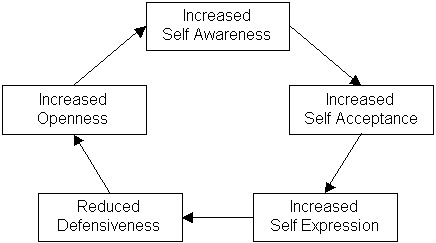Often in counseling, we restrict options out of fear that others will choose poorly, and because of a loss of control we might feel if others were truly free to choose. Roger’s principles address this shortcoming.
Three personal characteristics, or attitudes, of the therapist from the therapeutic relationship:
- Congruence / Genuineness
- Congruence is the most important of the three personal characteristics
- Congruence exists on a continuum
- Inner experience matches outer expression of that experience
- Authentic means spontaneously and openly being the feelings and attitudes, both negative and positive, that flow through self
- may necessitate showing anger, frustration, liking, concern, boredom, annoyance, etc.
- not necessary to show all… self-disclosure must be appropriate.
- Unconditional Positive Regard
- Attitude of what’s inside the client
- Deep and genuine caring
- Caring is unconditional … “I accept you as you are”
- It’s not possible to genuinely feel acceptance and unconditional caring at all times
- Differentiate acceptance of the person, from some of their behaviors which may be less acceptable.
- No evaluation based on good/bad
- Judgment is based on clients feelings, thoughts or behaviors
- Non-possessive caring
- Accurate, Empathetic Understanding
- Understanding of client experience and feelings in the moment-to-moment interactions
- Sense clients feelings as if they were his/her own, without becoming lost in those feelings
- Move freely in the world as experienced by clients
- Go beyond recognition of the obvious to the less clear feelings
- Deep subjective understanding of the client with the client
- Strive to sense clients subjective experience in the here and now
- Encourage client getting closer to themselves; feeling more deeply and intensely; recognize and resolve incongruities within themselves
- When the private world can be grasped, without losing separateness, constructive change is likely to occur

What is Person-Centered Therapy?
Rogers believed people are trustworthy and have vast potential for understanding themselves and resolving their own problems . . . and that they are capable of self-directed growth if they are involved in a respectful and trusting therapeutic relationship. (A-5)
- According to Rogers, if the above 3 attitudes are communicated by the helper, those being helped will become less defensive and more open to themselves and their world, and they will behave in social and constructive ways. (A-7) Therapists use themselves as an instrument of change. (B-203)
- Person-centered therapy focuses on the person, not on the person’s presenting problem. Goal is to assist clients in their growth so they are better able to cope with both today’s problems and future problems. (B-202)
- The basic drive to fulfillment implies that people move toward health if the way seems open for them to do so. Thus, the goals of counseling are to set clients free and to create those conditions that will enable them to engage in meaningful self-exploration. (A-7)
- Therapists concern themselves mainly with the client’s perception of self and the world. (A-8) This approach provides clients with a rare opportunity to be truly listened to without evaluation or judgment. (A-10)
- Therapist does not choose specific goals for the client. (B-203) Primary responsibility for the direction of therapy is on the client. (B-211)
- General goals of therapy are: a) becoming more open to experience, b) achieving self-trust, c) developing an internal source of evaluation, d) being willing to continually grow (B-211)
Limitations: Some therapists may not challenge the client enough. Some people may expect a more directive counselor and be put off by lack of structure. Some cultures value external locus of evaluation (rather than an internal source of evaluation) and may look to traditional expectations for direction. Also, focus on individual development may be at odds with cultural values that place importance on the common good. (B-216)
Relevance to ABS
- In the early 1940’s Rogers developed nondirective counseling (later he renamed it client-centered therapy; also known as person-centered approach). Rogers caused a furor when he challenged the basic assumption that “the counselor knows best.” (A-5)
- The above concepts were a major departure from the directive and psychoanalytic approaches to individual therapy. Rogers challenged the validity of commonly accepted therapeutic procedures such as advice, suggestion, persuasion, teaching, diagnosis, and interpretation. (A-5)
- Rogers’ client-centered philosophy was later applied to education and was called student-centered teaching. (A-5) Rogers also applied his approach to multicultural settings through international encounter groups. (A-18) He worked to reduce racial and political tensions in South Africa and Ireland (B-213).
- One of Rogers’ contributions to the field of psychotherapy was his willingness to state his concepts as testable hypotheses and to submit them to research. (A-17)
He literally opened the field to research. (B-212)
Sources
A. Selected Readings in Fundamentals of the Coaching and Counseling Relationship (LIOS handout)
B. Person-Centered Therapy (Chapter Seven from LIOS Library)
